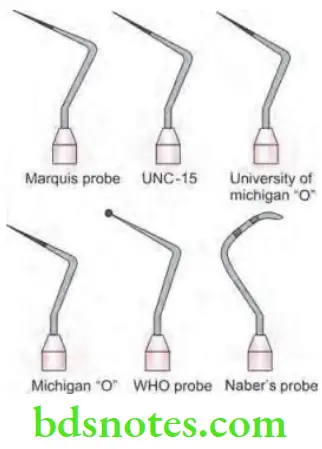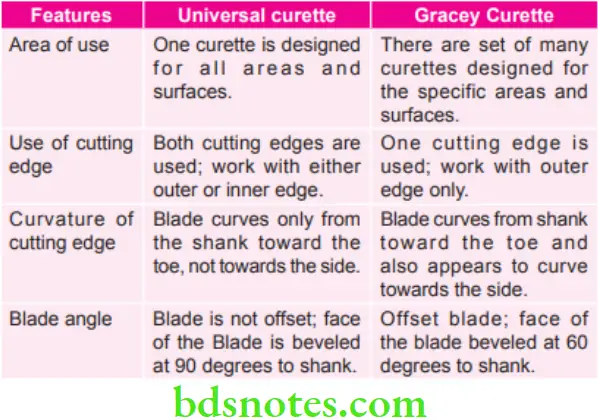Periodontal Instrumentation
Question 1. Write short note on types and uses of periodontal probe.
Answer. Periodontal probe is a tapered rod-like instrument with blunt round working end calibrated in millimeter and color-coding.
Periodontal probes are used to locate, measure and mark pockets, as well as determine their course on individual tooth surfaces.
Types of Periodontal Probes
Following are the types of periodontal probes:
- William’s probe: It is stainless steel probe. Diameters are available as 1 mm and 13 mm with markings at 1 mm, 2 mm, 3 mm, 5 mm, 7 mm, 8 mm, 9 mm and 10 mm. Markings of 4 mm and 6mm are missing which enhance the visibility and clear confusion in reading markings.
- WHO/CPITN probe: It has 0.5 mm ball at tip and millimeter markings at 3.5 mm, 8.5 mm and 11.5 mm and black color coding from 3.5 to 5.5 mm. They are of two types, i.e. CPITN – E probe and CPITN-C probe.
- CPITN-E (Epidemiological) probe: They have 3.5 mm and 5.5 mm markings.
- CPITN-C (Clinical) probe: They have 3.5 mm, 5.5 mm, 8.5 mm and 11.5 mm markings.
- UNC-15 probe: It is a 15 mm long probe with markings at each mm and color at 5th, 10th and 15th mm.
- Marquis color-coded probe: Calibrations are in 3 mm sections. The colored band on the periodontal probe is designed to make periodontal examination readings more objective and faster.
- Michigan “O” probe with markings at 3 mm, 6 mm and 8 mm.
- Goldman-Fox probe: Flat, rectangular probe with William’s markings at 1 mm, 2 mm, 3 mm, 5 mm, 7 mm, 8 mm, 9 mm and 10 mm.
- Naber’s probe: It is a curved probe designed to get access and determine the extent of the inter-radicular bone loss at furcation sites. It has color-coded markings at 3, 6, 9 and 12 mm.
- Moffitt/Maryland probe: WHO design with William’s markings.
- National Institute of Dental Research (NIDR) probe: Colorcoded and graduated in 2 mm increments at 2 mm, 4 mm, 6 mm, 8 mm, 10 mm and 12 mm with alternating increments colored in yellow.
Read And Learn More: Periodontics Question And Answers
- Florida probe: Gibbs et al. in the year 1988 developed the Florida probe system. This system incorporates constant probing force, precise electrical measurement and computer storage of data. The parts are probe hand piece, digital readout, switch, computer interface and computer. Two models have been developed which differ in their fixed reference point:
- Sterit model: The probe has 1 mm metal collar that rests on a prepared ledge on a prefabricated vacuform stent.
- Disk model: The probe has 11 mm disk which rests on the occlusal surface or incisal edge of the tooth.

-
- Toronto-automated probe: It is developed by researchers at the University of Toronto. Likewise, the Florida probe, the occlusal-incisal surface is measured with this probe to get clinical attachment levels. The sulcus is probed with 0.5 mm nickel-titanium wire, which extended under air pressure. The probe is useful to control angular discrepancies with the help of a mercury tilt sensor that limits angulation within 130°. But it requires reproducible positioning of the patients head and cannot easily measure 2nd and 3rd molars.
- Inter-Probe or Perioprobe: It is a third-generation probe and developed by Goodson and Kondon in 1988. This has an optical encoder transduction element with a flexible probe tip. The tip takes a curve with the tooth when the probe enters the pocket area. The probe optical encoder handpieces uses constant probing pressure to get repeatable measurement of pocket depth and attachment loss.
- The Jeffcoat probe or Foster-Miller probe: It was developed by Jeffcoat in 1986. It is capable of coupling pocket depth measurement with detection of the cementoenamel junction (CEI). The probe extends a thin metal fiber along the tooth surface into the sulcus and detects a slight acceleration rise when encountering the CEJ and then undergoes final extension, under constant force, on reaching the base of the pocket.
Uses of Periodontal Probe
- It measures the depth of gingival sulcus as well as gingival recession.
- It leads to the quantification of bacterial plaque as well as gingival inflammation.
- It determines mucogingival relationship.
- It locates the calculus.
- It identifies tooth irregularities and tissue characteristics.
- It determines bleeding tendency and presence of purulent exudates.
- It evaluates bone support in furcation areas of teeth.
Question 2. Write short note on periodontal probe.
Or
Write short note on generations of probes and limitation of conventional probe.
Answer. Periodontal probe is a tapered rod-like instrument with blunt round working end calibrated in millimeter and color coding.
- Periodontal probes are used to locate, measure and mark pockets, as well as determine their course on individual tooth surfaces.
- Based on the type of probe, markings vary from 1 mm to 15 mm.
- Periodontal probe consists of a handle, shank and working end. The angled shank forms 45° angle with working end in relation to the handle.
- Thin narrow working end is placed slowly up to the depth of periodontal pocket.
Generations of Periodontal Probe
- First generation probes: Conventional probes or manual probes
- Second generation probes: Constant force probes or pressure sensitive probes, e.g. true pressure sensitive probes.
- Force 30 g probe tip remain in CEJ and force of 50 g is necessary to diagnose osseous defects.
- Third generation probes: Automated probes, e.g. Florida probe, Foster Miller probe, Toranto-automated probe.
- Fourth generation probes: Three-dimensional probes. These probes are under the development phase. Main objective of development of these probes is to record sequential probe position along gingival sulcus.
- Fifth generation probes: Non-invasive three dimensional probes, e.g. Ultrasound probe. They will add ultrasound or another device to fourth generation probe.
Uses of Periodontal Probe
- It measures the depth of gingival sulcus as well as gingival recession.
- It leads to the quantification of bacterial plaque as well as gingival inflammation.
- It determines mucogingival relationship.
- It locates the calculus.
- It identifies tooth irregularities and tissue characteristics.
- It determines bleeding tendency and presence of purulent exudates.
- It evaluates bone support in furcation areas of teeth.
Limitations of Conventional Probes
- Probing depth obtained by the periodontal probe does not coincide with histological pocket depth because probe normally penetrates coronal level of junctional epithelium.
- Reproducibility, which is correlated with variation in probing force.
- Intra and inter-examiner reliability, patient discomfort accuracy of probe markings and anatomical variation in tooth contour or position are some of the factors which are likely to influence clinical measurement of attachment level.
Question 3. Write short note on classification of periodontal instruments.
Answer.
Classification of Periodontal Instruments:
According to the Purpose
- Periodontal probes
- Explorers
- Scaling, root planning and curettage instruments
- Sickle scalers
- Curettes
- Hoe, chisel and file scalers
- Ultrasonic and sonic instruments
- Periodontal endoscope
- Cleansing and polishing instruments, e.g. rubber cups, brushes, dental tape
Periodontal Probes
They are used to locate, measure and mark pockets, as well as determine their course on individual tooth surfaces.
Explorers
Used to locate calculus deposit and caries
Scaling, Root Planning and Curettage Instruments
They are used for removal of plaque and calcified deposit from crown and root of tooth, removal of altered cementum from subgingival root surface, and debridement of soft tissue lining the pocket. Scaling and curettage instruments are classified are:
- Sickle scalers are heavy instruments use to remove supragingival calculus.
- Curettes are fine instruments used for subgingival scaling, root planning and removal of soft tissue lining the pocket.
- Hoe, chisel and file scalers are used to remove tenacious subgingival calculus and altered cementum. Their use to limited as compared to curettes.
- Ultrasonic and sonic instruments are used for scaling and cleansing tooth surfaces and curetting the soft tissue wall of periodontal pocket.
Periodontal Endoscope
It is used to visualize deeply into subgingival pocket and furcations, allowing the detection of pockets.
Cleansing and Polishing Instruments
These are rubber cups, brushes and dental tape, they are used to clean and polish tooth surfaces. Also available are air-powder abrasive systems for tooth polishing.
Question 4. Write short note on Gracey curettes.
Or
Write short note on area specific curettes.
Or
Describe Gracey curettes.
Answer. Gracey curettes were designed in late 1930s by Dr.Clayton H Gracey, a periodontist at University of Michigan.
- These are area-specific curettes, designed and angled to adapt specific anatomic areas of the dentition.
- These curettes and their modifications are probably the best instruments for subgingival scaling and root planning because they provide the best adaptation to complex root anatomy.
- The term offset blade is used to describe Gracey curettes, because they are angled approximately 60–70° from the lower shank.
- This unique angulation allows the blade to be inserted in a precise position, necessary for subgingival scaling and root planning, provided that the lower shank is parallel to the long axis of the tooth surface being scaled.
- Double-ended Gracey curettes are paired in the following manner:
- Gracey # 1–2 and 3–4 : For anterior teeth
- Gracey # 5–6 : For anterior teeth and premolars
- Gracey # 7–8 and 9–l0 : Posterior teeth; facial and lingual surfaces
- Gracey # 11–12 : Posterior teeth; mesial surfaces
- Gracey # 13–14 : Posterior teeth; distal surfaces
Recent Additions to Gracey Set
- Gracey #15–l6: It is a modification of Gracey No. 11–12 and is designed for the mesial surfaces of posterior teeth. It consists of Gracey No. 11–12 combined with more acutely angled Gracey No. 13–14 shank. The new shank angulation of Gracey No. 15–16 allow better adaptation to posterior mesial surfaces from a front position with intra-oral rest.
- Gracey # l7–18: It is a modification of Gracey No. 13–l4. It has a shank elongated by 3 mm and a more accentuated angulation of the shank. It has better access to all posterior distal surfaces.
Modifications of Gracey Curettes
Extended Shank Curette
Extended shank curettes such as Hu-Friedy after five curettes, are modifications of standard Gracey curette design. Terminal shank is 3 mm longer and allows extension into deeper periodontal pockets of 5 mm or more.
The Gracey Curettes
They are another set of four mini-bladed curettes. The blade length of these instruments is 50% of conventional Gracey curette, and blade has been curved slightly upward.
- Sub-0 and the No. 1–2 are used for anteriors and premolars
- No. 11–12 is used for posterior medial surfaces
- No. 13–14 is used for posterior distal surfaces.
Langer and Mini Langer curettes
It is the set of three curettes which combine the shank design of standard Gracey Nos. 5–6, 11–12 and 13–14 curettes with universal blade honed at 900 rather than offset blade of Gracey curette. These instruments can be adapted to both mesial and distal tooth surfaces without changing the instruments.
Question 5. Write short note on Gracey curettes and mini-bladed Gracey curettes.
Answer.
Mini-bladed Gracey Curettes
- They are modifications of After Five Curettes.
- The blade is commonly half in the length compared to after five or standard Gracey curettes.
- The shorter blade allows easier insertion and adaptation in deep, narrow pockets, furcations, developmental grooves, line angles, and deep, tight, facial, lingual, or palatal pockets.
- They are available in both rigid and finishing designs.
- Rigid mini fives are recommended for calculus removal.
- More flexible shanked, finishing mini fives are recommended for light subgingival scaling and root planning in periodontal maintenance patients.
- Mini-bladed Gracey curettes come in all standard Gracey numbers except for no. 9–10.
- Microminibladed Gracey curettes have blade 20% thinner than Mini five Gracey curettes to further reduce tissue distention and ease subgingival insertion.
Question 6. Write differences between universal and gracey curettes.
Answer. Following are the differences between universal and gracey curettes:


Leave a Reply